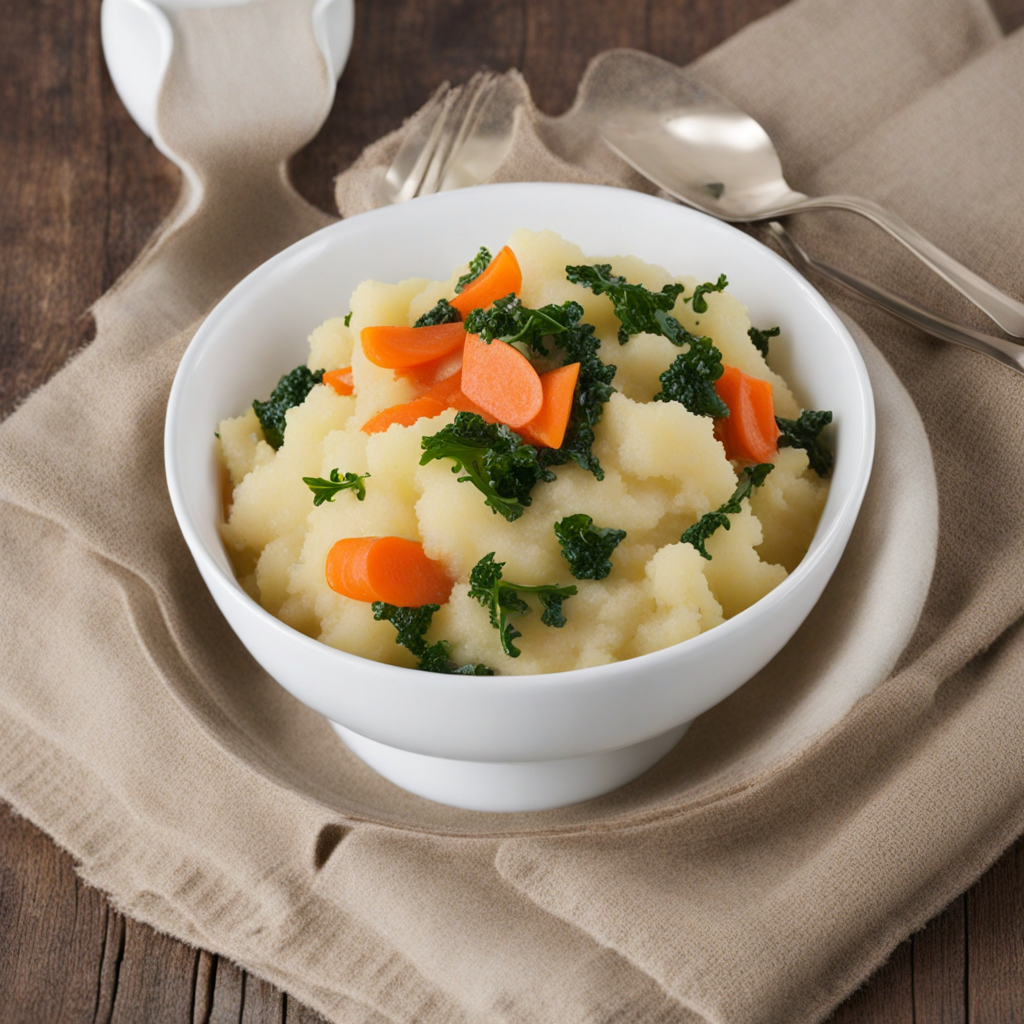Stamppot
Stamppot is a traditional Dutch dish that beautifully embodies the heartiness and simplicity of Northern European cuisine. At its core, it consists of a comforting mash made from potatoes combined with various vegetables, creating a dish that is both filling and flavorful. Common vegetables used in stamppot include kale, sauerkraut, carrots, and endive, each adding its unique texture and taste to the mix. The potatoes are boiled until tender, then mashed together with the chosen greens to create a creamy, rustic dish that is often served as a staple during the colder months. The dish is typically accompanied by a deliciously savory sausage known as "rookworst," which adds a smoky flavor that complements the earthiness of the mashed potatoes and vegetables. When served, stamppot is often drizzled with a bit of gravy or melted butter, enhancing its richness and inviting further indulgence. The contrast between the creamy texture of the mash and the juicy sausage creates a satisfying mouthfeel that makes every bite enjoyable. This dish is not only about taste but also about warmth and comfort, making it a beloved choice for family gatherings and festive occasions. Stamppot is more than just a meal; it represents a connection to Dutch agricultural traditions, showcasing the importance of seasonal, locally sourced ingredients. Each region in the Netherlands may have its variation of stamppot, incorporating different vegetables and spices to reflect local tastes and preferences. As you savor this dish, you'll appreciate the balance of flavors and the way it brings people together, making it a perfect introduction to the rich culinary heritage of the Netherlands.
How It Became This Dish
Stamppot: A Hearty Dutch Tradition Origins and Historical Context Stamppot, a quintessential dish from the Netherlands, is an emblem of Dutch culinary heritage, characterized by its simplicity and heartiness. The name "stamppot" translates to "mash pot," which is fitting as the dish primarily consists of mashed potatoes combined with various vegetables. The origins of stamppot can be traced back to the 17th century, a period of immense prosperity for the Netherlands, often referred to as the Dutch Golden Age. During this time, the Netherlands not only became a major trading power but also established a rich cultural and gastronomic identity. The staple ingredients of stamppot—potatoes and root vegetables—reflect the agricultural practices of the time. Potatoes were introduced to Europe from South America in the late 16th century and quickly adapted to the Dutch climate. They became a vital part of the Dutch diet, especially in rural areas where other crops might not thrive. Vegetables such as kale, sauerkraut, carrots, and turnips were commonly grown in Dutch gardens and farms, making them readily available for use in the dish. Cultural Significance Stamppot is more than just food; it is a cultural symbol of Dutch comfort and communal dining. Traditionally, it has been associated with the colder months, as its warm and filling nature provides a satisfying meal during long, harsh winters. The dish embodies the Dutch philosophy of "gezelligheid," which refers to a sense of coziness and togetherness that comes from sharing food with family and friends. In the past, stamppot was often prepared by farmers and laborers who needed a nutritious meal to sustain their hard work. The dish reflects the Dutch values of frugality and resourcefulness, using local, seasonal ingredients to create a filling meal. The practice of "stamping" or mashing the ingredients together signifies unity, as families would often gather around the table to enjoy their meal together, fostering a sense of community. Regional Variations and Ingredients As stamppot evolved, regional variations began to emerge, showcasing the diversity of Dutch ingredients and cooking styles. Each region of the Netherlands has its own unique take on the dish, often influenced by local produce and culinary traditions. One of the most popular variations is "boerenkool stamppot," which incorporates curly kale into the mashed potatoes. This version has gained significant popularity and is often served with rookworst, a Dutch smoked sausage, adding a smoky flavor that complements the dish beautifully. Another favorite is "hutspot," made with a mixture of potatoes, carrots, and onions—originally believed to have been created during the Siege of Leiden in the 1570s, when residents had to rely on whatever food they could find. Additionally, "zuurkool stamppot" features sauerkraut, giving it a tangy flavor that contrasts with the creamy potatoes. Other versions include variations with spinach, endive, or even various types of cheese. The adaptability of stamppot allows it to be personalized according to individual tastes and regional availability, ensuring its lasting appeal across generations. The Role of Stamppot in Modern Dutch Cuisine In contemporary Dutch cuisine, stamppot has made a successful transition from a humble peasant dish to a beloved national treasure. It remains a staple in many households, often prepared during winter months and special occasions. The dish has also found its way into restaurants, where chefs are experimenting with modern twists, incorporating gourmet ingredients, and elevating the traditional preparation methods. Stamppot has increasingly become associated with the concept of "Dutch comfort food." Its warm, hearty nature makes it a go-to meal for families and friends gathering during the colder seasons. The dish is often accompanied by a side of gravy or a dollop of mustard, further enhancing its rich flavors. Moreover, the rise of interest in sustainable and local eating has contributed to the resurgence of traditional dishes like stamppot. As more people seek to understand the origins of their food and prioritize locally sourced ingredients, stamppot’s reliance on seasonal vegetables makes it an appealing option. It not only celebrates the history of Dutch agriculture but also aligns with modern values of sustainability and environmental consciousness. Conclusion: A Culinary Legacy Stamppot is a dish that captures the essence of Dutch culture—rooted in history, reflecting communal values, and adaptable to changing times. From its humble beginnings as a farmer's meal to its status as a beloved national dish, stamppot represents the heart and soul of Dutch cuisine. It stands as a testament to the ingenuity of the Dutch people, who have skillfully combined simple ingredients to create a dish that brings warmth and comfort to the table. As stamppot continues to evolve, it remains a symbol of unity and tradition, inviting people to gather, share stories, and celebrate the richness of Dutch culinary heritage. Whether enjoyed at home, in a cozy restaurant, or during festive gatherings, stamppot will forever hold a special place in the hearts and palates of those who cherish this hearty Dutch classic.
You may like
Discover local flavors from Netherlands







